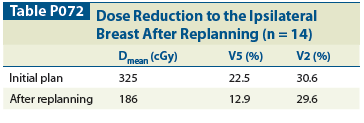(P072) Reducing Radiation Dose to the Breast in Female Patients Undergoing Stereotactic Body Radiotherapy for Lung Cancer
Stereotactic body radiotherapy (SBRT) is gaining prominence as an effective treatment for early-stage inoperable non–small-cell lung cancer (NSCLC). To date, little attention has been paid to the radiation dose delivered to the breast tissue in female patients.
Table P072

Todd J. Carpenter, MD, Michael H. Buckstein, MD, PhD, Blagoja Todorov, BS, CMD, Sheryl Green, MBBCH, Kenneth E. Rosenzweig, MD; Icahn School of Medicine at Mount Sinai
Purpose and Objectives: Stereotactic body radiotherapy (SBRT) is gaining prominence as an effective treatment for early-stage inoperable non–small-cell lung cancer (NSCLC). To date, little attention has been paid to the radiation dose delivered to the breast tissue in female patients.
Materials and Methods: We retrospectively reviewed the treatment plans and dose–volume histograms of all female patients undergoing lung SBRT at our institution from July 2010 to October 2013. No dose constraints were placed on the breasts initially. Bilateral breasts were retrospectively contoured to determine the dose received. The 14 plans receiving the highest mean ipsilateral breast dose were replanned, taking into account the breasts as organs at risk (OARs) using the following published constraints developed to minimize contralateral breast dose during intensity-modulated radiation therapy (IMRT) breast cancer treatment: Dmean < 2 Gy; V5 < 15%; and V2 < 50%. Statistical analysis was performed using SPSS v19.
Results: A total of 84 patients underwent lung SBRT at our institution during the study period, of whom 42 were female. Twelve were excluded from this analysis because of a history of previously treated breast cancer (n = 7) or previous thoracic radiation (n = 5). Of the remaining 30 patients, the median age was 79 years (range: 59–94 yr). The predominant histology was adenocarcinoma (n = 24). Tumor stage was as follows: T1a = 12, T1b = 11, and T2a = 7. Twenty tumors were right-sided, eight were left-sided, and three patients presented with bilateral tumors. Median dose was 48 Gy in four fractions (range: 32.5–56 Gy). Median planning target volume (PTV) was 30.2 cc. The median Dmean, V5, and V2 received by the ipsilateral breast initially were 261 cGy, 19.5%, and 26.2%, respectively. PTV and breast volume were not significant predictors of any of the aforementioned dosimetric parameters. Isocenter location anterior to the carina did significantly correlate with the ipsilateral breast Dmean and V5 (P < .05 for both). Results of the 14 patients who were replanned are shown in Table 1. Dmean, V5, and V2 were significantly lowered after replanning (P < .05 for all). Replanning did not significantly increase the total lung V20, ipsilateral lung V20, chest wall V30, heart Dmax, esophagus Dmax, contralateral breast Dmean, or V2. There was a nonsignificant increase in the ipsilateral breast Dmax. The spinal cord Dmax and contralateral breast V5 were significantly increased, though still within tolerance.
Conclusion: This study demonstrates that incorporating constraints that minimize breast dose in lung SBRT is feasible and does not result in excess dose to other critical structures. With increasing long-term survivorship after SBRT for early-stage NSCLC, there is a commensurate increasing likelihood of patients developing a metachronous primary breast cancer. Limiting the dose to the breast, especially for tumors anterior to the carina, may preserve the option of breast-conserving therapy in those patients, as well as lower the as-yet unquantified risk of radiation-related late toxicity in the breast.
Targeted Therapy First Strategy Reduces Need for Chemotherapy in Newly Diagnosed LBCL
December 7th 2025Lenalidomide, tafasitamab, rituximab, and acalabrutinib alone may allow 57% of patients with newly diagnosed LBCL to receive less than the standard number of chemotherapy cycles without compromising curative potential.